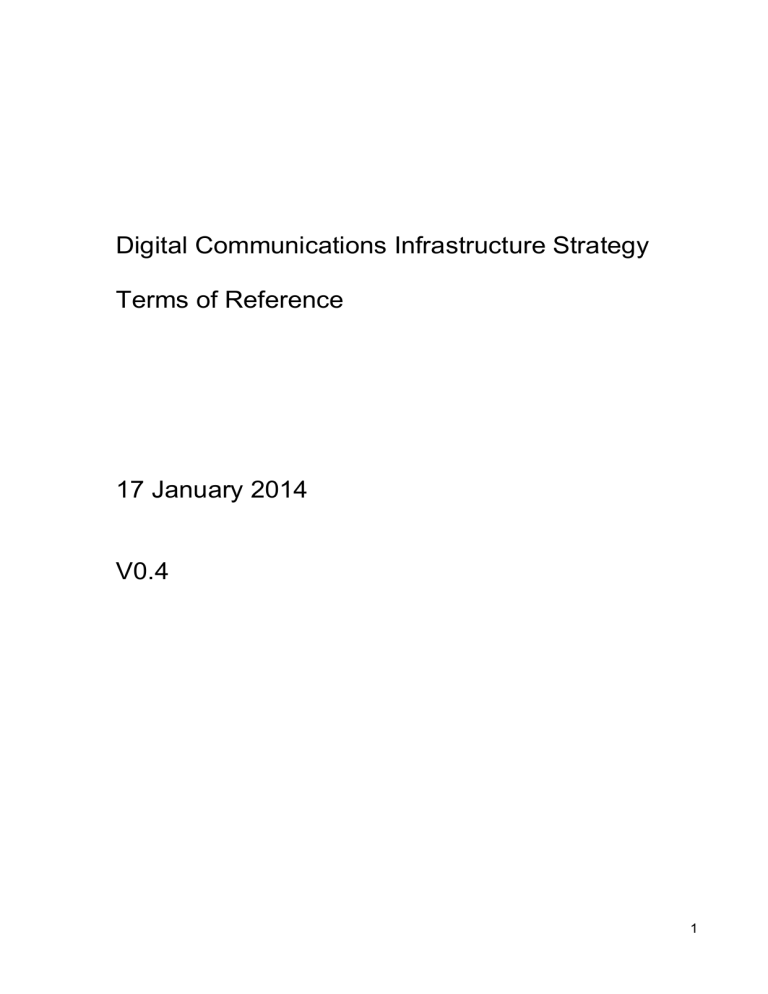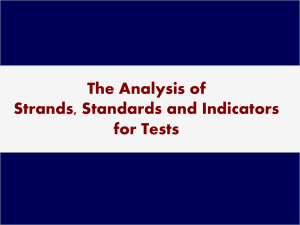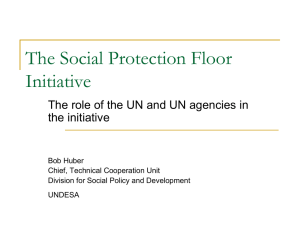Digital Communications Infrastructure Strategy

Digital Communications Infrastructure Strategy
Terms of Reference
17 January 2014
V0.4
1
Contents
2. Objective ............................................................................................................ 3
3. Scope……………………………………………………………………………............5
4. Outputs and Timing ............................................................................................ 7
2
1.
Introduction
1.1 The Information Economy Strategy was published in June 2013 and set out how the expectations of business and consumers on the availability, cost, speed, security and reliability of the internet are increasing all the time. The
Government recognises that meeting these demands will be crucial in reinforcing the UK’s position as a leading digital economy and driving jobs, investment, productivity and growth.
1.2 The document “Connectivity, Content and Consumers” was published in July
2013 by the Department for Culture Media and Sport (DCMS). This announced that the Government would develop a Digital Communications Infrastructure
Strategy to continue to drive innovation, productivity and economic growth in the UK.
1.3 This document publishes the terms of reference for the strategy.
1.4 The overall aim of the strategy is to establish the right framework for the UK’s future digital communications infrastructure based on a high level understanding of potential data volumes, market developments across the communications sector and future demand for technology and services from consumers, business and the public sector.
2 Objective
2.1 A successful economy, with the societal benefits that flow from that, requires the right infrastructure. Having the right digital communications infrastructure is, and will remain, an essential component of a successful UK economy. As a country we need plan ahead to ensure that the UK’s digital infrastructure is comparable to the best in the world.
2.2 The Digital Communications Infrastructure Strategy will set out what the UK needs to do to ensure that this infrastructure is in place, identifying the roles of
Government, industry and the regulator, Ofcom, in making it a reality.
2.3 The strategy will be built around a number of likely scenarios for the future of the UK
’s digital communications, based on potential user demand (users being consumers, business and Government itself). The strategy will look at those user needs for the period 2015 – 2025/30 and identify the broad policy and regulatory steps Government will need to take, in partnership with industry.
This is intended to provide greater certainty for industry, to ensure that planning, investment and development are facilitated and not hindered.
2.4 The strategy will examine whether and how other countries are tackling this issue and any strategies they may have in place over the relevant period, to see if there are lessons for the UK and to ensure that the UK’s strategy enables its infrastructure to be amongst those of the leading nations.
2.5 As well as the demand scenarios, the Strategy will be informed by a high-level analysis of the likely developments in technology and communications markets over the next 10-15 years, and the opportunities that this provides the UK, both
3
in terms of potentially boosting the country’s trend growth rate and also in transforming the way in which services are delivered to consumers by the public and private sectors. The strategy will draw on expert analysis from leading thinkers in the electronic communications and information economy sectors and will adopt a technology neutral approach that is based on the
Government’s commitment to Open Standards. Fixed, fixed-wireless, mobile and satellite communications will all have a role to play in achieving world class and ubiquitous connectivity. It will also complement other Government strategies already announced e.g. the Information Economy Strategy published last June.
2.6 The Strategy will inform the Government’s National Infrastructure Plan in relation to the future development of the communications sector and its potential investment needs and as such should be consistent with the
Government’s wider approach to infrastructure.
2.7 In particular the strategy shall include an assessment of: a) A high level view of t he UK’s current position, comprising:
Existing and planned committed provision of digital communications infrastructure assets (both privately and publicly funded); and
The supply market for the provision of and access to digital communications infrastructure. b) A high level view of what our infrastructure might look like after 10-15 years and future demand, taking into account scenarios for potential future data volumes including:
The technology available and required that the strategy should provide for. This should take into account known future developments, for example, the likely take-up of IPv6 alongside IPv4, white space radio technology, big data, cloud computing, fixed-mobile convergence, future mobile (5G), the Internet of Things, smart utility networks and smart cities;
The needs of consumers, businesses (including small businesses) either as consumers or suppliers of communications services - the science and research community, and the public sector;
The provision of digital communications infrastructure including the efficient use of current and planned infrastructure;
The scope and level of competition in the provision of and access to digital communications infrastructure;
Any relevant comparisons with strategies set out by other countries; and
Market developments in other key countries
A n y relevant environmental issues, such as planning, power consumption etc.
4
c) How to ensure that the UK takes advantage of the growth potential that this sector provides, including:
‘Early mover advantage’ in developments in the digital age;
The delivery of benefits that are enabled by the provision of world class digital communications infrastructure;
Supporting initiatives on boosting innovation in the provision and use of digital communications infrastructure; and
The UK’s global competiveness in this sector d) The steps required to facilitate and encourage private sector investment in digital communications infrastructure. e) Developments in the regulatory environment including:
The role of Ofcom in facilitating and encouraging investment in digital communications infrastructure;
Potential regulatory interventions that may be required to facilitate the
Government’s vision; and
Potential developments in pan-European electronic communications regulation, such as the Framework Directive, and including the State
Aid environment. f) The role of Government including:
How best to coordinate the Government’s policies, programmes and investment which support or depend upon digital communications infrastructure;
The policy interventions that the Government may need to make e.g. to address any market failure, to ensure that the infrastructure is in place to deliver the vision;
Protection of the security and resilience of the digital communications infrastructure, building on existing Government initiatives in this area.
2.5 The Strategy will identify key next steps and action points for delivery.
3 Additional Information
3.1 The digital communications infrastructure consists of those elements of the
UK’s economic infrastructure that comprise the data transport network. Digital communications infrastructure assets include fixed, mobile, fixed wireless and satellite networks. Fixed wireless networks will also be taken to include the
UK’s television and radio broadcast networks. The strategy will need to take account of the likely development of Internet Protocol Television (IPTV) within the period of the strategy.
3.2 The strategy will assess the extent to which elements of the UK’s core telecommunications networks and local access networks should be covered.
5
As a minimum the strategy will cover the future provision of broadband services.
3.3 This is a UK wide strategy on which we will consult with the Territorial Offices and Devolved Governments. Telecommunications and wireless telegraphy remain Reserved Matters.
3.4 One of the key inputs to the Strategy is the UK Government’s 10-15 year
Spectrum Strategy, which will be published in early 2014. Other inputs that are planned to complete during the strategy review include:
BDUK’s Broadband Impact Study, which will include assumptions about future coverage and speed, as part of its model to estimate the potential impact of BDUK’s work on the UK’s society and economy. This was published in November 2013;
BDUK’s Baseline Report, documenting the broadband landscape of the UK prior to the Government’s investment in BDUK.
The Broadband Stakeholder Group’s forecasting work on Domestic
Demand for Bandwidth. This was published in November 2013;
The work of the Future of Innovation in Television Technology Taskforce
(FITT), whose final report will be published in May 2014;
Ofcom reports including 2013 & 2014 UK Communications Infrastructure
Reports
3.5 The strategy will focus on the infrastructure needs of the UK. As such, the following areas are considered to be out of scope for the Digital
Communications Infrastructure Strategy, although where it is relevant to reference them the strategy will do so:
the provision of content and services across digital communications infrastructure other than in respect of any impacts on network requirements and supply and demand;
Intellectual property rights and other rights issues;
The delivery of digital government services, other than in respect of any impacts on network requirements and demand;
Research, education and skills issues other than in respect of any impacts on network requirements and demand;
Digital security, consumer confidence and safety other than in relation to the resilience and security of Critical National Infrastructure;
Current initiatives on digital inclusion, take up and use; and
The role of public service broadcasters.
6
4 Outputs &Timing
4.1 The project will be led by six key work strands, as outlined in Paragraph 2.7, although the work for these will be inter-related:
Work Strand A: Summary of UK’s current position
Work Strand B: High level view of the potential future demand and usage, including international comparisons
Work Strand C: Taking advantage of the growth potential of the sector
Work Strand D: Facilitating and encouraging private sector investment
Work Strand E: The regulatory environment
Work Strand F: The role of Government, including policy interventions, security and resilience
4.2 An interim report on progress will be published by July 2014 for consultation. A final report will be produced by December 2014.
4.3 Views are invited on any or all of the areas referenced in paragraph 2.7, or any other issues that are felt to be relevant to future infrastructure requirements.
Responses should be sent by 28 March 2014 to dcis@culture.gsi.gov.uk
7











